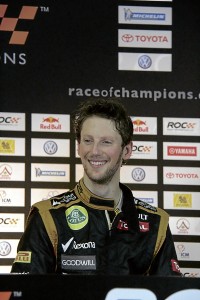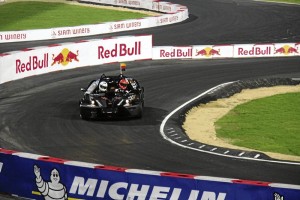BANGKOK, Thailand—Three-time Formula One world champion Sebastian Vettel and seven-time Formula One world champion Michael Schumacher delivered a sixth consecutive win for Team Germany in the Nations Cup category in the Race of Champions held at the Rajamangala Stadium here over the weekend.
The individual category, which carried the 2012 Champion of Champions title, went to Formula One driver Romain Grosjean, who beat Audi Le Mans driver Tom Kristensen, 2 to 0, in a tightly contested final race.
Le Mans legend Tom Kristensen found himself blowing his bid for the second straight time as French Formula One driver Grosjean, ranked eighth for Lotus in the Formula One standings this year, proved steadier in their duel.
The Race of Champions (ROC) is an international motorsports event traditionally held at the end of the year, featuring some of the world’s best race drivers in Formula One (F1), World Rally Championship (WRC), MotoGP, NASCAR and other racing disciplines using sportscars, touring cars and special buggies, competing against each other in identically built cars. The first race was held in 1988 by former rally driver Michele Mouton and IMP (International Media Productions) president Fredrik Johnsson.
Drivers vied for two titles, the “Champion of Champions” and the Nations Cup, which was added in 1999 featuring teams of two drivers who compete for their country in a head-to-head knockout event.
Each year, the ROC event is held in different and several venues, from Stade de France in Paris to the new Wembley Stadium in London in 2007. This race was held for the second time in
Asia. In 2009, it was held in Beijing’s Bird’s Nest Stadium. The format for the race varies slightly from year to year but basically, the event groups the drivers into eight pairs of teams based on nationality or region. Among cars selected for the ROC have included a specially prepared dune buggy, a World Rally Car, KTM’s X-Bow and grand touring race cars.
Several types of cars are used in the ROC, and over the course of the race, each driver will have to drive several different cars. Aside from the ROC dune buggy, other cars used in the race include the Audi R8 LMS, Lamborghini Gallardo Super Trofeo, KTM X-Bow, Volkswagen Scirroco and the V-8 powered cars from Euro Race Car. Like in other ROC races, it is designed to have a short and tight track to make the races exciting on a stadium venue where the whole course is basically visible to the spectators.
Michelin for 25 years now
Aside from having identical cars, for the last 25 years since its inception, all the vehicles used in the race run on Michelin tires. It has been ROC’s technical partner since 1988, the year when ROC held its first race. Pascal Couasnon, Michelin’s racing division director said, “Michelin is proud to have been a technical partner of the Race of Champions since it first began. It is about pitting the best drivers from a variety of backgrounds and disciplines against each other. The high standard of the competitors and the competition expected between them means it is only fitting that they have the best possible equipment. Michelin will use its long and successful record in motorsport around the world to ensure this happens.”
Michelin is one of the pioneers of motor racing over a hundred years ago and is the first brand in motorsport history to capitalize on the endorsement potential of tires in motor racing.
“We are the first tire maker to use motor racing as proving grounds for our products,” said Couasnon. “After being tested in the extreme conditions of a race track, innovations that increase tread life, ensure sustainable tire performance, improve safety and enhance energy efficiency are then transferred into Michelin passenger car tires.”
He also said that the company does not believe in producing high-performance tires simply for “entertainment” reasons or to enhance spectacular special effects unlike some other brands in the highly competitive and political brand endorsement market.
Michelin, he said, believes in the practice of using technology to improve performance, quality and endurance of tires to make sure it performs optimally at all times from race start to the very end. He cited Le Mans endurance races and the varying wet and dry conditions of rally racing as prime examples of R&D for developing their tires.



